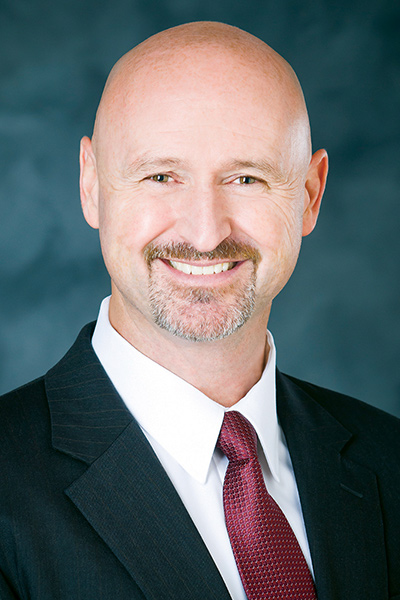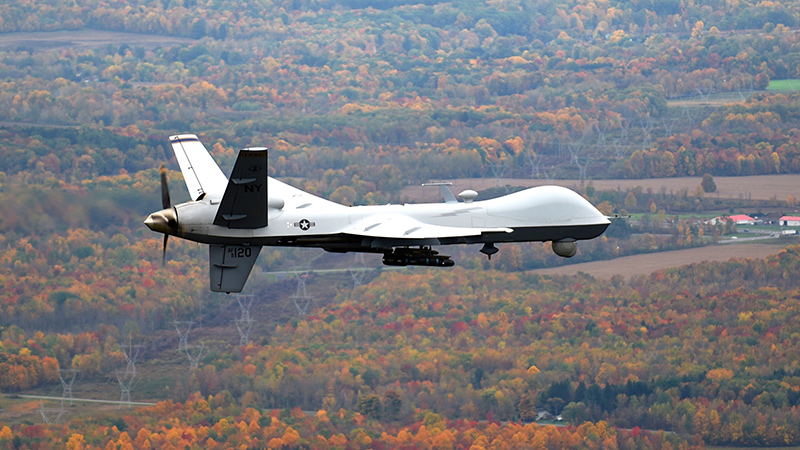Toward “a beautiful web of airplanes”
By Debra Werner|May 2017
READ THE REST OF OUR COVERAGE FROM MAY’S SPECIAL REPORT ON DRONES.
It would be hard to find anyone who has done more to begin integrating unmanned aircraft into the U.S. national airspace than Dallas Brooks. After an Air Force career that included a stint as the chief of unmanned aircraft systems integration policy, Brooks led a Pentagon task force that worked to ease restrictions on military UAS flights in the U.S. He’s now director of Raspet Flight Research Laboratory, which specializes in unmanned and conventionally piloted flight testing and is an FAA UAS test site. I spoke with Brooks about the challenge of integrating a wide range of UAS, from hand-launched 1.9 kilogram Ravens to 2,200 kilogram military Reapers, into U.S. airspace.
Q: How do you get your arms around a problem as large as integration of UAS of all sizes in the national airspace?
Introducing a new technology like UAS into an airspace system that has been predicated on a human pilot being in a cockpit for 100-plus years is a huge challenge. Virtually all of today’s flight regulations levy the ultimate responsibility for safe flight upon that human pilot in the cockpit. In the case of UAS, that paradigm is turned on its head. The cockpit is no longer in the airplane and the pilot no longer directly sees out of the window. So we have to look at how we allocate duties and responsibilities in a way that keeps the rules appropriate and enforceable without necessarily reinventing everything.
Beyond the technical and regulatory integration challenges, there are some cultural and human challenges as well. When you are not sitting in the cockpit, are you as cognizant of the dangers? Are you as alert as you might otherwise be?
It is an extraordinarily large and complex problem set. Trying to treat it like a single problem is usually the way that you fail.
Q: How do you succeed?
One of the most successful approaches is to eat away at it a bite at a time. Divide it into component problems and determine what is achievable today in terms of finding compromises between current regulation, advanced aviation technology and new processes or procedures. To do that effectively, you have to truly understand the processes that drove the original regulations. Only then can we effectively look at how we can either modify UAS to meet those concepts or, when UAS can’t be modified and there is substantial public benefit, then potentially look at revising some of those regulations to allow for those benefits to be realized. Not just because it’s a UAS, but because the public truly sees a value and is rewarded by the operation of the UAS.
Q: What is that value?
There are so many aspects of unmanned systems that are tremendously beneficial. In some respects, UAS represent the future of aviation. UAS can put sensors in the air to accomplish scientific research, everything from analyzing crops to monitoring the environment to finding and repairing power line or pipeline problems. Because they can stay in the air far longer than a human pilot, UAS can search for lost people, track environmental disasters, or help contain extremely hazardous situations, such as radiation leaks. The benefits are tremendous, and that’s before you even begin to assess the potential economic benefits.
Q: What are the component problems that need to be tackled?
Probably the most important one is the reliability of the system. Since there is no human pilot in the cockpit, the UAS has to be absolutely, fundamentally reliable to do what you expect it to do in the event of some malfunction or other off-nominal event. While we do our best as a government to regulate the design and construction of the systems that go into an aircraft, at the end of the day if the system breaks down and other systems break down, the fallback is the pilot’s judgment and the pilot’s actions. If everything else fails and your cockpit goes dark, and you cannot reach air traffic control, that human pilot takes over and uses his best judgment to navigate his way to a safe outcome. When you have an unmanned system in the air, and those same systems sometimes fail, even if they are built to the same level of reliability, then what happens? We can build aircraft to take over for the pilot and do very reliable things, such as auto-divert and auto-land, but our air traffic system must be set up to accept that.
Q: If the command link is lost, what do the UAS do?
One of the benefits of UAS is that should the aircraft lose contact with its control station, it does exactly what it is programmed to do. Human pilots don’t always do that. In some cases, that programming is simple, in other cases, it can be very complex. The Air Force’s Global Hawk is capable of executing a “decision tree” depending on a variety of factors such as location, altitude, et cetera. These contingency options might in some cases provide a divert path to an alternate airport, where the aircraft would automatically fly the published approach and land. Another option might be to alter course to a more remote location, away from other aircraft. But to execute such options safely and without disruption, our air traffic management system, including the pilots of other aircraft, must understand what to expect as well as the UAS pilot does. We’re not there yet, but we’re getting closer.
Q: How does the FAA’s Next Generation Air Traffic Control System help or hinder UAS integration?
The devil is in the details with NextGen. I maintained in 2005, when NextGen was still being formed, that if you designed the system around the most highly automated aircraft — unmanned systems — that would unlock the highest efficiency. From there, you can back down the technology to accommodate less automated, less capable aircraft. But if you designed the system fundamentally around the same stick and rudder stuff that we’ve been doing for years, then it’s going to be very tough to integrate new technologies. That argument fell on deaf ears for a number of years.
Q: Why would that approach make sense?
If you design the system to accept an aircraft that will take off, climb, level off, compute the most effective route corrections, negotiate those corrections directly with the air traffic system, make it all the way to its destination and taxi to its hangar, all with literally not a single radio call, then you’ve optimized what the air traffic system is capable of doing.
Q: That would all be done by transferring data?
Yes. When you think of what NextGen was going to provide, it was going to automate systems, and provide more efficient routing. Every aircraft, as opposed to following our current system of “roads in the sky,” would compute the most efficient route. The computers that run the system would deconflict by time, altitude or other means to ensure that two aircraft would never cross the same place at the same time. We have that kind of computing power and reliability today. Quite frankly, the least reliable piece of that equation is the human pilot. Their skill levels vary. But with an automated system talking to an automated system in a way that both tie in directly and can adjust to each other, the efficiency goes through the ceiling. It becomes a beautiful interconnected web of airplanes going where they need to go when they need to go there.
Q: What insights are you drawing from the ASSURE research initiative?
The research being done by ASSURE is addressing the most critical questions that must be answered if we are to truly integrate UAS into the NAS. One example is assessing the severity of an impact between a UAS and a manned aircraft. For years, we assumed if there’s an impact, it would automatically be assumed as catastrophic. If a UAS hits an airplane, we are going to assume that airplane is going to crash, period. That assumption makes it very tough for any UAS to pass certain safety thresholds for operating in dense flight environments.
But we know that a collision between a UAS and a manned aircraft isn’t necessarily catastrophic — partially because it’s happened. There was an incident overseas where an RQ-7 Shadow hit a C-130 and the C-130 landed safely. The Shadow is a 375-pound [170 kilogram] airplane, not a small UAS, so that was a serious incident — but it wasn’t catastrophic. The question is, when does it become catastrophic? Under what conditions? What size or weight, what density, what relative airspeed, what angle of collision? We’ve never had the data, because true impact testing has never been done. While it’s pretty easy to assume that below a certain weight or density the UAS might scratch the airplane or chop the propeller a little bit but the airplane is going to be OK, but we don’t know for sure until we test it exhaustively.
Q: How do you gather that data? Do you crash UAS?
In some cases yes, but not with airplanes flying in the sky. We’re doing extensive 3-D modeling, and following that up with actual test-firing of UAS components at various aircraft components to verify that our models are accurate. As you might expect, it’s not the small plastic parts on the outside of a UAS that cause the damage. It’s the dense pieces like the motor or the battery. As part of our research scheme, we are firing UAS motors and batteries into aircraft components like wing skins and engines to see what damage they might do. At what level of penetration would the skin begin to separate or rupture? At what velocities? At what densities? At what angles?
We’re doing similar work to assess how harmful a UAS can be if it impacts a person on the ground. That’s a very different thing, and the safety thresholds must be much, much higher. The UAS must be relatively small, slow, and light to ensure they won’t harm an unprotected person. We’re evaluating just how small, slow and light is enough.
Related Topics
Military Aircraft"We can build aircraft to take over for the pilot and do very reliable things, such as auto-divert and auto-land, but our air traffic system must be set up to accept that."
Dallas Brooks, director of Mississippi State’s Raspet Flight Research Laboratory
Dallas Brooks
- Director of Mississippi State’s Raspet Flight Research Laboratory
- Co-chairs the UAS Scientific Research Panel, a group led by the FAA, Defense Department, NASA and the Department of Homeland Security to align UAS airspace integration science and research initiatives
- 26 years in U.S. Air Force
- Mississippi State leads the Alliance for System Safety of UAS through Research Excellence, or ASSURE, a group of 23 research institutions designated by the FAA as the country’s UAS Center of Excellence









